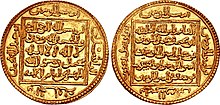Muhammad al-Nasir
| Muhammad al-Nasir | |
|---|---|
| Caliph of the Almohads | |
 | |
| Ruler of the Almohad Caliphate | |
| Reign | 1199–1213 |
| Predecessor | Abu Yusuf Yaqub al-Mansur |
| Successor | Yusuf II, Almohad caliph |
| Born | c. 1182 |
| Died | 1213 (aged c. 30–31) |
| Spouse | Qamar |
| Issue | Yusuf II |
| Dynasty | Almohad |
| Father | Abu Yusuf Yaqub al-Mansur |
| Religion | Islam |
Muhammad an-Nāsir (Arabic: الناصر لدين الله محمد بن المنصور, an-Nāṣir li-dīn Allah Muḥammad ibn al-Manṣūr, c. 1182[1] – 1213) was the fourth Almohad caliph from 1199 until his death.[2] Contemporary Christians referred to him as Miramamolin.
On 25 January 1199, al-Nasir's father Abu Yusuf Yaqub al-Mansur died; al-Nasir was proclaimed the new caliph that very day.[2] Al-Nasir inherited from his father an empire that was showing signs of instability. Because of his father's victories against the Christians in the Iberian Peninsula (Al-Andalus), he was temporarily relieved from serious threats on that front and able to concentrate on combating and defeating Banu Ghaniya attempts to seize Ifriqiya (Tunisia). Needing, after this, to deal with problems elsewhere in the empire, he appointed as governor of Ifriqiya, so unwittingly inaugurating the rule of the Hafsid dynasty there, which lasted until 1574.
Dynasty and Iberian presence[]
He now had to turn his attention back to Iberia, to deal with a crusade proclaimed by Pope Innocent III. This resulted in his defeat by a Christian coalition at the Battle of Las Navas de Tolosa (1212). He died the following year, and was succeeded by his young son Yusuf al-Mustansir, born of Christian slave Qamar.[3]
Relationship with King John of England[]
In the early 13th century, John, King of England was under pressure after a quarrel with Pope Innocent III led to England being placed under an interdict, by which all forms of worship and other religious practices were banned. John himself was excommunicated, parts of the country were in revolt and there were threats of a French invasion.
Writing two decades after the events, Matthew Paris, a St Albans chronicler of the early thirteenth century, claims that, in desperation, John sent envoys to al-Nâsir asking for his help. In return John offered to convert to Islam, to make the country at disposal of the caliph and turn England into a Muslim state. Among the delegates was Master Robert, a London cleric. Al-Nâsir was said to be so disgusted by John's grovelling plea that he sent the envoys away. Historians have cast doubt on this story, due to the lack of other contemporary evidence.[4][5][6][7]
Viziers[]
- Abu Zayd bin Yujan (1198–1199)
- (1199–1205), the future governor of Ifriqiya (see above)
- Abu Sa`id Uthman ibn Jam`i (1205–1214)
References[]
- ^ Rademacher, Cay: Der Kampf um Spanien., in: GEO EPOCHE 31, 2008, p. 33.
- ^ a b Évariste Lévi-Provençal, al-Nāṣir. Encyclopaedia of Islam, Second Edition. Brill Online, 2013. Reference. 9 January 2013.
- ^ Yusuf II al-Mustansir Billah
- ^ Chesterton, G.K. (1925). The Everlasting Man. London: Hodder & Stoughton. p. 215.
- ^ Ronay, Gabriel (1978). The Tartar Khan's Englishman. London: Cassel. pp. 28–34. ISBN 1-84212-210-X.
- ^ Graham Stewart, The king who wanted Sharia England. The Times, 16 February 2008
- ^ John Derbyshire, United States of Islam. National Review Online, 12 October 2001
Bibliography[]
- Charles-André Julien, Histoire de l'Afrique du Nord, des origines à 1830. 1931.
- 1213 deaths
- 13th-century Al-Andalus people
- 12th-century Almohad caliphs
- 13th-century Almohad caliphs
- 12th-century Berber people
- 13th-century Berber people